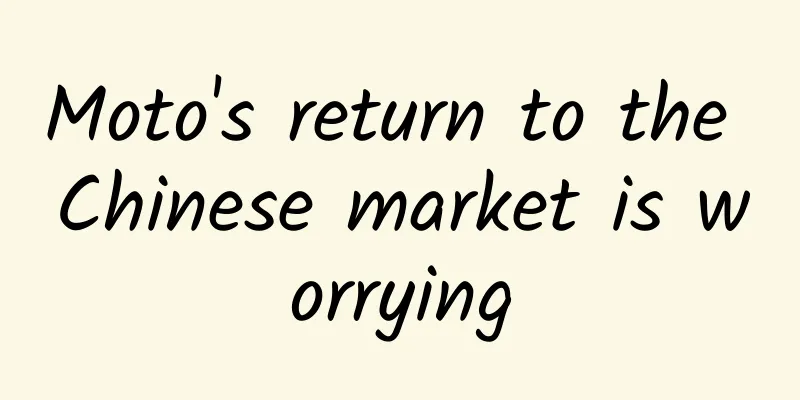Moto's return to the Chinese market is worrying

|
"Hello, Moto", the long-lost mobile phone ringtone, is about to be fully revived in the Chinese market. At the 2015 CES in the United States, executives of Motorola and its new shareholder Lenovo Group confirmed to the media that Motorola will officially return to the Chinese market on the 26th of this month. The first mobile phone will be launched before the Chinese New Year. But the Chinese mobile phone market is no longer what it used to be. After several rounds of reshuffles among mobile phone manufacturers, many domestic mobile phone brands have emerged, and new mobile phone brands such as Samsung and Apple have seen their market share in China shrink. Now that Motorola has returned, what will be its future in the market? Lenovo values Moto's brand strengths Lenovo Group's executive chairman Yang Yuanqing had planned to sell 100 million mobile phones in 2015. Motorola's president recently said in a media interview that Motorola would account for a considerable share of the total. When mobile communications were just starting, "Hello, Moto" was the most high-profile startup ringtone in the mobile phone market. But in the 2G era, this sound was gradually drowned out by the "Nokia tune" ringtone. At the beginning of the 3G era, if you accidentally hear someone's mobile phone "Hello" in a public place, it usually draws a burst of laughter. In 2011, Google acquired Motorola Mobility for approximately $12.5 billion , but it failed to save Motorola. In the Chinese market, Motorola's dealer chaos was constantly exposed by the media. After experiencing multiple layoffs and turmoil, Motorola withdrew from the Chinese market in 2013. In 2014, Lenovo took over Motorola Mobility. At the 2015 CES Consumer Electronics Show held last week, Liu Jun, executive vice president of Lenovo Group and president of the Mobile Business Group and chairman of the Motorola Mobility Management Committee, announced that Motorola will return to China before the Spring Festival. It was revealed that Lenovo will hold a press conference on January 26 to announce its specific plan to return to the Chinese market. "Although Moto has withdrawn from many markets under the leadership of Google, its software research and development capabilities have been greatly improved in the past two years. Moto will be redeveloped before being brought back to China. While ensuring the native Android system, it will also add Chinese-style applications such as the app store," said Liu Jun. Previously, Lenovo’s senior management team emphasized on many occasions that Moto’s brand advantages remain. When announcing the acquisition, Yang Yuanqing said that he planned to sell 100 million mobile phones in 2015. Motorola President and COO Rick Osterloh said in a recent media interview that Motorola would account for a considerable share of the total. Before exiting the Chinese market, Motorola was pursuing a high-end route, and will pursue a mid-to-high-end route after returning. Lenovo's own mobile phone brand is positioned as a mid-to-low-end route in China. Compared with Huawei and Xiaomi , Lenovo's mobile phone operations are more traditional, mainly relying on physical channels and operator customization, and its channel relationships are mainly in the Chinese market. Wang Yanhui, secretary general of the China Mobile Alliance, analyzed that although Motorola's business has shrunk under Google's management, its sales channels in the European and American markets have been preserved, especially its relationships with operators, which can help Lenovo quickly increase sales in overseas markets. In addition, Motorola can also make up for Lenovo's shortcomings in patents and innovation. Lenovo and Motorola's combined market share currently ranks third in the smartphone market, behind only Apple and Samsung. Previously, Yang Yuanqing made it clear that he hopes to replicate Lenovo's successful path in the PC field in the mobile phone field, using quantity to ensure low costs and low prices in exchange for greater sales and form a positive cycle. Industry insiders said that after Motorola returns to China, Lenovo will open up the sales channels of the two companies at home and abroad, and Lenovo's "impulse volume" plan will be officially launched. Positioning low-end or high-end? Regarding the positioning of the first three new products revealed by Liu Jun, analysts believe that they continue Motorola's high-end aristocratic positioning; Motorola President Rick tends to focus on popular-priced, cost-effective mobile phones. Motorola, Lenovo, and Lenovo's newly launched high-end sub-brand VIBE, Lenovo now has at least three independent mobile phone brands. Many analysts said that how Lenovo distinguishes the three brands and how Motorola positions and prices them will be the key to Motorola's success in China. After reviewing recent statements by Lenovo and Motorola executives to the media, the reporter discovered that there seems to be no consensus within Lenovo on the positioning of Motorola. Liu Jun revealed at CES that the first three new products to return are the new Moto G targeting the mainstream population, the Moto X targeting the high-end population, and the new Moto X Pro targeting the even higher-end population. According to insiders, the new Moto G is expected to cost 1,499 yuan, the new Moto X is expected to cost 3,499 yuan, and the Moto X Pro is expected to cost more than 5,000 yuan. However, Motorola and Lenovo officials have not confirmed this statement yet. Analysts said that this positioning will continue Motorola's original high-end aristocratic positioning and can evoke the nostalgia of Motorola's original fans. Motorola President Rick prefers to focus on affordable and cost-effective mobile phones. He told the media at his first appearance in Chinese media last month that Motorola will position itself as a challenger in the market, and will focus on mid-to-high-end mobile phones in its sales strategy, and will gradually cover mobile phone products at all price levels in the future. Rick said that the high prices in the mobile phone industry will be unsustainable in the future, and the trend will be more towards high cost performance and low-end. Therefore, Motorola returned to China, mainly to compete with Xiaomi and Huawei. Many mobile phone industry experts, including Wang Yanhui, believe that lowering their profile and competing with Xiaomi and Huawei should be the best option for Motorola. After all, Motorola has been silent for too long, and many new consumers born after 1990 do not know Motorola, and new consumer groups happen to be the key to the future development of the brand. Even for old mobile phone users, the probability of changing their phones for the return of Motorola is not high. Li Yi, executive vice president of the China Mobile Internet Industry Alliance, is very optimistic about Motorola's return prospects, but Li Yi also believes that Motorola must "reduce its dimensions" and at least lower its prices to "above ZTE and below Huawei." User customization leads to concerns Rick said that in the future Moto will give consumers the right to choose and achieve customization in hardware and software. However, the industry is worried that its single product will be difficult to support the huge traffic costs. Wang Yanhui believes that in addition to market positioning, another factor that determines the prospects of Motorola's return is sales strategy. According to Lenovo executives, Motorola will mainly focus on e-commerce platforms and customization in the future. At CES, Liu Jun said that the first new Moto X phones to be launched will have different colors and materials for users to choose from, and its full version of the customization service will be launched within a few months. Motorola President Rick told the media that the near-death experience allowed Motorola to rethink its products and manufacturing capabilities, including the ability to produce thousands of different configurations of the Moto X. In the future, Moto will give consumers the right to choose, including which style of mobile phone to choose. Rick said: "In the past few years, we have been remaking Motorola. The new goal is to sell better products to end consumers, giving them more choices, including decisive personalized elements, not only providing different materials for the back cover in hardware, but also making the system customizable in software." However, industry insiders expressed concerns about this. An analyst said that Motorola's single product line makes it difficult to support the huge traffic costs. Many PC manufacturers have tried the customization route before, but consumers did not respond strongly. Moreover, the configurations of mobile phones priced above 2,000 yuan are similar. With the current product scale of Motorola, it is not suitable to make customized machines. The cost is too high. If it is to be made, it should stay at the appearance level. As for sales channels, Yang Yuanqing revealed, "Lenovo mobile phones are mainly aimed at operator customized channels and low-end mobile phones, VIBE is positioned in the open market, and Motorola uses more online sales channels. It uses the online model in the UK and has an experience base." In overseas markets, the Lenovo brand and Motorola are advancing into emerging markets and mature markets respectively. Wang Jun, an analyst at Analysys International, also believes that after its return, Motorola should operate with an Internet mindset. If it uses operator channels, Motorola will basically have no future in China. "The transformation to the Internet is the key to Motorola's future development." Lenovo's "last chance" China has become the world's largest smartphone market, so Rick stressed that Motorola must come to China. But Motorola is no longer what it used to be, and the Chinese market is no longer what it used to be. In recent years, China's mobile phone market has been saturated. According to data released this week by the China Academy of Information and Communications Technology, the total shipments of mobile phones in China in 2014 were 452 million units, a decrease of 21.9% from 2013. According to the forecast of the authoritative organization IDC, the month-on-month growth rate of China's smartphone shipments will drop to 7.8% in 2015. At the same time, competition in the domestic mobile phone market has continued to intensify, local mobile phone brands such as Huawei have risen strongly, and OPPO, Meizu and others have been controlling the market segments. Wang Yanhui said that after the reshuffle in the past two years, the competition among domestic mobile phone manufacturers has changed from competing in sales volume to competing in product characteristics, and the pattern has initially emerged. Several companies including Huawei, OPPO and vivo have found their own brand characteristics. In addition, the mobile phone businesses of Huawei and other companies have achieved considerable revenue in 2014, all of which are over 10 billion RMB. In comparison, Lenovo's mobile phone products are not very distinctive and are still on the profit and loss line. Wang Yanhui is worried that the polarization trend in the domestic market will intensify in 2015. Lenovo and Motorola are still struggling to find their way, and they will be left behind by Huawei and others. "It doesn't make much sense to simply talk about sales volume now. The Chinese market has passed the stage of competing for volume." As market space shrinks and domestic "coyotes" emerge, Samsung, Apple and other companies are facing a crisis of survival in the country. Data previously released by Strategyanalytics, a US market research firm, showed that Samsung's share of the Chinese smartphone market has been declining since 2014, reaching 19%, 14.3% and 13.3% in the first, third and fourth quarters of 2014, respectively. At the same time, Apple's market share in China also hit a new low of 4.7% in 2014. In this context, it remains unknown whether Motorola can snatch the food from the tiger's mouth and cross the dangerous shoal. Wang Jun believes that Motorola will have no problem turning losses into profits, but it is unlikely to even make it into the top ten of the domestic mobile phone rankings in the short term. Li Yi is optimistic about Motorola's prospects in China, and believes that as long as it lowers its dimension and does not compete with Samsung and Apple, Motorola will have a chance to succeed. But Wang Yanhui believes that in the current domestic competitive environment, Motorola will be Lenovo's last chance for mobile phone business in the domestic market. Motorola's major events in China 1987 The first office was established in Beijing. 1992 Motorola (China) Electronics Co., Ltd. was established in Tianjin with an investment of US$120 million. 1987 to 2004 It is the leader in the Chinese mobile phone market. Since 2002 Constantly challenged by Nokia. June 2004 Motorola (China) Technologies Co., Ltd. was established, integrating the R&D capabilities of Motorola (China) in Beijing. Since then, 18 R&D centers and laboratories have been established in China. Started in January 2007 Its market share in China has been falling from 20.3%. 2009 Apple leads the 3G trend, while Motorola accelerates its decline; its dealers have repeatedly revealed that the company's channels are in chaos. 2011 MOTO was officially split into Motorola Mobility and Motorola Solutions Division; 7 months later, Google acquired Motorola Mobility for US$12.5 billion. 2012 Motorola's Nanjing research center was closed, leaving only the Beijing R&D center in the country, and the laid-off employees collectively protested. 2013 Motorola withdraws from the Chinese market. January 2014 Lenovo acquires Motorola's smartphone business from Google for $2.9 billion. As a winner of Toutiao's Qingyun Plan and Baijiahao's Bai+ Plan, the 2019 Baidu Digital Author of the Year, the Baijiahao's Most Popular Author in the Technology Field, the 2019 Sogou Technology and Culture Author, and the 2021 Baijiahao Quarterly Influential Creator, he has won many awards, including the 2013 Sohu Best Industry Media Person, the 2015 China New Media Entrepreneurship Competition Beijing Third Place, the 2015 Guangmang Experience Award, the 2015 China New Media Entrepreneurship Competition Finals Third Place, and the 2018 Baidu Dynamic Annual Powerful Celebrity. |
<<: Can the self-produced talent show help Sohu Video regain its momentum?
>>: The PC industry is unable to grow rapidly. Are Microsoft and Intel stuck in a quagmire?
Recommend
What may be causing your allergies is not the flowers and plants, but the tall trees
Data show that compared with previous years, the ...
ARKit & OpenGL ES - ARKit principle and implementation
Principle If you want to learn more about OpenGL ...
What is the relationship between the "trumpet worm" with amazing regenerative ability and humans?
When we first looked up at the starry sky, we cou...
"Arts and Sciences" in the Television Industry
As the iteration of TV products accelerates, TV m...
The first phase of Jiuji original painting online class [HD quality]
The first phase of Jiuji original painting online...
The color TV industry is still the same and there is no story to tell
The color TV market in the first half of 2016 (th...
How to find accurate seed users? Attached with classic practical cases!
Analysis ideas for finding seed users : The follo...
Speech recognition is not a difficult task, speech synthesis is the challenge
I believe most people are familiar with voice ass...
Short video promotion skills in the home improvement industry, with successful cases!
Advertising is the first impression that consumer...
Tips for making popular short videos!
I have always wanted to interview Zhu Feng to tal...
GAC Aion AION Y, a 100,000-level high-tech first-class cabin, officially goes on pre-sale starting at 105,900 yuan
On March 29, the "AION Y YES! Urban Trendy S...
After Apple and Samsung's high-end phones were "cold"
The recent financial reports of Apple and Samsung...
6 ways to sell products through live streaming on Xiaohongshu!
Since 2019, Xiaohongshu has officially launched t...
How to make a Baidu Encyclopedia of characters? Which reference material is better?
How do I create a character entry in Baidu Encycl...
What do you think of the suddenly disappearing stars and twinkling stars?
A strange star flickering in the center of the Mi...









